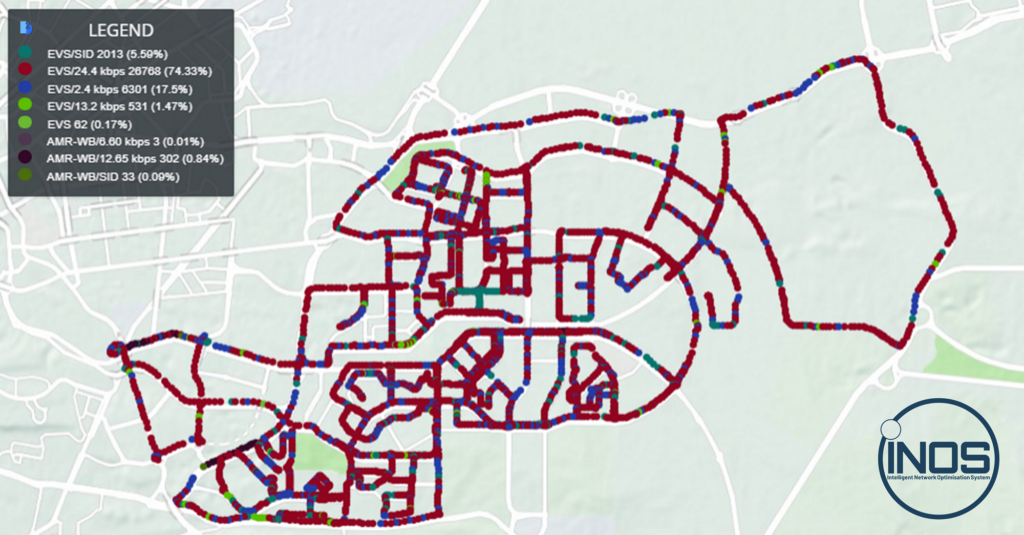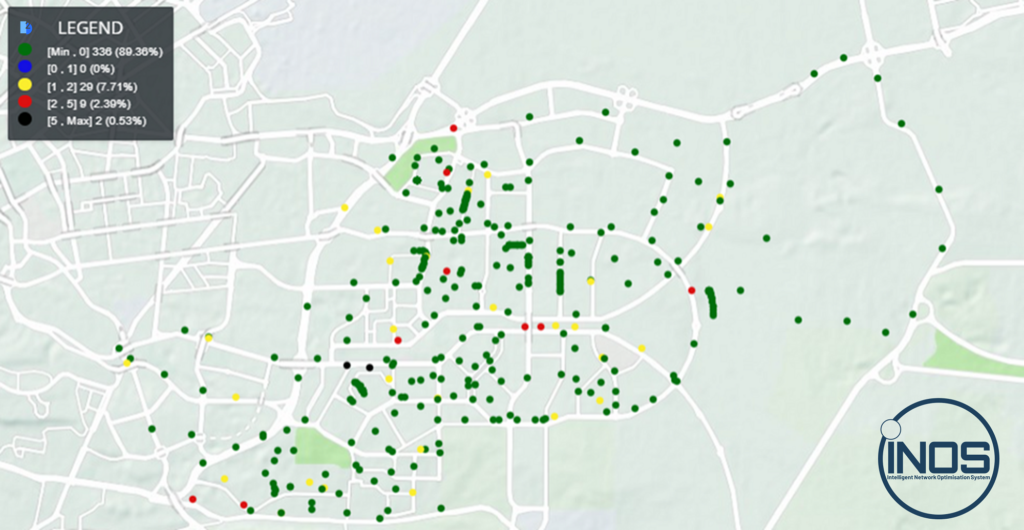Can you hear me now?
In a world where mobile communication is focused on the use of apps and data, does the quality of a voice call still matter? And is it worth communications service providers (CSPs) spending effort on improving it?
In this blog post Amr Ashraf, Digis Squared’s RAN and Software Solution Architect and Trainer argues that “Yes, it absolutely is! Voice quality, and particularly silence within calls – can you still hear me? – is one of the most tangible aspects of network quality for end users.”
Read on for insights into Digis Squared’s AI-centered voice call quality testing capabilities, using INOS.

If it’s important, we call.
Does voice quality still matter? “Yes! As voice technologies continue to evolve, and call costs drop, it continues to be important to ensure that the quality and clarity of voice calls is maintained,” explains Amr Ashraf, RAN and Software Solution Architect and Trainer.
“The phone call, the most basic and original capability of the mobile phone service, is also the most tangible for end users. Despite the huge range of apps we have on our phones, more often than not, it’s a voice call that’s used for communicating the most important, most sensitive and most urgent information.”
If we can’t clearly hear and understand what is being spoken on a call, or in a voice note, whichever app or method is used to connect or send the audio, then the customer’s perception is always that the network coverage or capacity is of low quality.
“If you find yourself saying ‘Can you still hear me? Are you still there?’, or thinking ‘What did they say?’, then the assumption is that the ‘fault’ is a poor quality service from the CSP”, says Amr. “Of all the aspects of a mobile network, voice quality is the strongest and most obvious indicator to an end-user of the quality of the service. Customers’ expectations of voice quality remain high, whichever technology the digitalised sound is transmitted over.”
Voice technologies today
Today, whilst some traditional mobile voice calls are still carried over legacy circuit-switched networks, calls made over 4G and higher, and for all app-based solutions, these digitalised sounds are transmitted as Voice over IP (VoIP), Voice over LTE (VoLTE) and Voice over WiFi (VoWiFi), all of which enable cost-effective ways to transport voice. Having a single solution that can assess voice quality across all technologies, in an automated and efficient way is vital – and in the web of complex multi-system networks, that AI-centred voice call quality testing solution must also work with solutions from all vendors.
INOS
Digis Squared’s INOS AI tool is a vendor agnostic, multi-network-technology solution delivering automated assessment, testing and optimisation of networks, across all technologies.

INOS & voice call quality testing
“If one of our clients – a CSP, MNO, MVNO or regulator – wants to better understand voice call quality on a specific mobile network, then we use our INOS AI tool to analyse the data,” shares Amr.

Notes on Image 1: For a voice call to be transmitted over the mobile network, it must first be digitized and compressed. Various standardized compression technologies, or codecs, are used to efficiently transmit the data. This image shows data collected during voice calls during a drive test, and the key on the left shows the codec used.
Enhanced Voice Rate (EVS) and Adaptive Multi-Rate (AMR) are audio compression formats used in the transmission of voice calls – EVS is a super-wide coding standard developed for VoLTE, and AMR is the older standard developed for GSM and UMTS (3G), sometimes called HD+.
Image 1 shows the variation in codec and compression rate utilised during test voice calls, made during a drive test. The changes in codec and compression rate are caused by changes in network coverage and capacity during the coverage, and will have resulted in fluctuations in call quality.
“Using INOS, we can simulate a customer call using the voice quality test to produce unbiased, industry-recognized audio quality scores,” explains Amr. “This test can reveal a great deal about your customers’ experience, as well as the quality of service being provided by your carrier. It also takes minimal preparation to undertake.”
Vital to this test is POLQA – Perceptual Objective Listening Quality Analysis – the global standard for benchmarking voice quality of fixed, mobile and IP-based networks. Standardized by the ITU in 2011, it is used for voice quality analysis of VoIP, HD Voice, 3G, 4G/VoLTE and 5G networks.
“So, whilst drive testing with the INOS kit, we set up a voice call and then use our own hardware solution to inject a POLQA reference audio into the voice call from one side of the call, and from the other side, we record the call, and then compare it using the POLQA algorithm.”
“Given that the POLQA reference audio is 6 seconds long, to analyse this data, we must split our call into audio files that are each only 6 seconds long. To ensure very precise splitting of the audio file, we leverage our AI engine to find the beginning of specific words in audio files. This way, we can ensure that we are aligning the analysis with natural speech patterns, and achieve a more realistic analysis of the data.”

Notes on image 2: using data from the same drive test shown in image 1, now the data has been analyzed by INOS, and split into 6 second chunks, aligned with the start of specific spoken words in the audio file.
In telecoms, the Mean Opinion Score (MOS) is a numerical measure of the overall ranking of the quality of voice and video sessions. In image 2 above, we can see that on this journey, only a small minority of sections score the minimum 1 MOS (in black), and most of the call is green (MOS 3 and 4).

Notes on image 3: again using the same data as above, here the data is averaged out for specific calls, rather than 6 seconds chunks of a call shown in image 3.
INOS & silence within a call
“Silence within a call is a major problem with mobile phone conversations, and significantly impacts the customers’ perception of call quality. We’re all familiar with having to say ‘Can you still hear me? Are you there?’ whilst one of the people on the call is travelling in a car or bus,” continues Amr.
“To measure this, the Digis Squared team utilize our in-house AI capability within INOS to detect silence in voice calls, and analyse the percentage of silence.”

Notes on image 4: this analysis identifies areas where silence during the call was detected. Green indicates no silence, and in yellow, red and black are increasing amounts of detected silence.
INOS: automated, actionable voice call quality reports
INOS delivers automated voice quality reports, with customised KPIs, and actionable insights.
Amr concludes, “All our INOS reports can be fully customised, and are generated within 15 minutes of receipt of the data file, sent directly from the test devices in the field, over the air. What our clients find most useful is that not only are the reports conveniently formatted for immediate use, they also, thanks to our AI engine, clearly identify issues and provide actions which can be taken to address those issues. Data is no use without analysis, and the AI capabilities we have developed within INOS ensure that the analysis is fast, efficient and actionable.”
Find out more about INOS
INOS can be implemented as a public or private cloud, or on-premise solution, and is also available as a “Radio Testing as-a-service” model. Its extensive AI-analysis and remote OTA capabilities ensure speedy and accurate assessment of all aspects of network testing: SSV, in-building and drive testing, network optimisation and competitor benchmarking, across all vendors, network capabilities and technologies, including 5G, private networks and OpenRAN.
INOS is built with compute resources powered by Intel® Xeon® Scalable Processors. Digis Squared is a Partner within the Intel Network Builders ecosystem program, and a member of the Intel Partner Alliance.
In conversation with Amr Ashraf, Digis Squared’s RAN and Software Solution Architect and Trainer.
If you or your team would like to discover more about our capabilities, please get in touch: use this link or email sales@DigisSquared.com
Discover more
- Product update: “Radio Testing as a Service” – successful cloud-based INOS installation in Intel Lab
- Image credits: all images, except first, copyright Digis Squared. First image (woman on phone) Gabriel Gonzalez
About Digis Squared
Managed Services, System Integration & Consulting. We transform telecom networks, deploy new technologies, and manage vendors, for network operators, service providers and regulators. Apply our vendor-agnostic expertise, automated AI-led tools and processes to transform your technical and commercial capabilities. We work with agility, deep experience, and our in-house cognitive tools to optimise and manage multi-vendor networks across all technologies. Headquartered in the UK, Digis Squared has offices in Angola, Egypt and UAE.
Digis Squared ◦ Enabling smarter networks.

